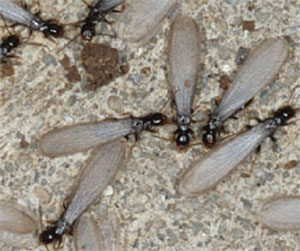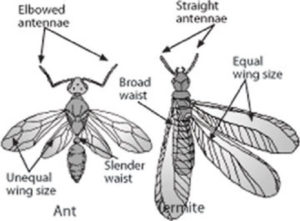Termites cause over 5 billion dollars worth of damage a year. Another 2.2 billion is spent on the control of termites each year. They will invade any structure from the Statue of Liberty to the White House to your house. No structure is immune. A quality pest prevention specialist is your best guarantee, whether you live in Raleigh, Charlotte, Wilmington or a surrounding area.

 How to Identify Termites
How to Identify Termites
The most common termite colony that we have in this area of North Carolina is the eastern subterranean termite colony. A termite colony consists of the primary reproductives (also know as swarmers or winged reproductives), the queen, workers, soldiers and supplementary reproductives. What most homeowners usually see first are these swarmers or shelter mud tubes.
Termite swarmers’ (winged reproductives) bodies are about 3/8″ long and black to dark brown. Their bodies are shaped with no apparent distinct body parts and a thick waist that gives it a shape of your finger. Swarmers have four equal wings that are translucent or milky color with no apparent veins and extend beyond the abdomen. Sometimes the homeowner will only see the discarded wings in great numbers and no insects. The termite has straight antennae. Swarmers usually emerge from an infested tree stump or log or they can swarm inside a home or structure. They can swarm by the hundreds or thousands. This swarm happens usually from March to June but can also happen in autumn. The only purpose of the swarmers is to reproduce and start new colonies; it does no damage but can be frightening to homeowners when they see hundreds or thousands. When you see swarmers, it is a mature colony.
The signs of a termite’s presence are:
- Small holes in wood
- Crumbling drywall or indentations in drywall; the termites have eaten the paper off the drywall
- Sagging doors and floors
- Mud tubes in any location that are in contact with the ground
- Shed wings
Difference Between Winged Termites and Winged Ants
Often people will see swarms of winged ants and think that they are seeing termites. The following image illustrates the difference between the two. You don’t want termites OR ants!
The Biology and Habits of Termites
The termite queen and king are primary reproductives. As the colony develops, the queen’s only purpose is to lay eggs. She can live up to 30 years and can lay between 5,000 to 10,000 eggs per year once the colony is mature. These eggs develop into the 3 different castes: workers, soldiers, and reproductives, (primary and secondary). Mature colonies can have 60,000 workers. There is no wonder they do so much damage!
The workers: Are the most numerous individuals in the colony and perform all the work and DO ALL OF THE DAMAGE. This includes making tunnels, grooming the queen and feeding the other members. The worker has the ability to chew wood or cellulose. This is where the damage comes from as well as their economic significance. The workers, during their molting, can become soldiers, swarmers or secondary reproductives.
The soldiers: The soldier’s only purpose is to defend the colony. When the mud tubes are damaged, they aggressively defend the colony until the workers repair the mud tubes.
They have large heads and use their large jaws against the intruder. They are far fewer than the workers.
The reproductives: These are the swarmers described in the identity section. The secondary reproductives can change due to the needs of the colony. They are in older, more mature colonies. They can also produce eggs and in a crisis or if needed, they can serve as replacements to the primary reproductives.
Ways to reduce the conditions that harbor and attract termites:
- Remove leaf clutter near structure and in gutters
- Remove earth-wood contact
- Remove and do not store any wood in the crawl space
- Re-direct sprinklers away from the structure
- Keep mulch away from structure
- Do not stack wood next to structure
- Remove infested stumps and trees
- Reduce moisture content in crawlspaces
- Repair all leaks in structure inside and out
- Make sure water is graded away from structure (including air conditioners)
- Install moisture barriers over 80 to 90% of crawl space
- Make sure all stucco and form boards are at least 4 inches from ground
- Seek professional assistance Economy Exterminators can help. Call us today!


 How to Identify Termites
How to Identify Termites



